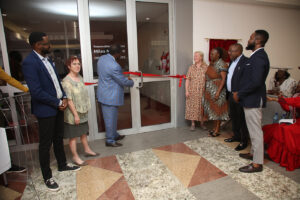The University of Namibia (UNAM) approved the establishment of a Namibia Green Hydrogen Research Institute following its Senate approval on 2 September 2021.
UNAM embarked on this initiative to establish a national institute in May 2021 and has since secured a number of local and international partners to drive green hydrogen research in Namibia – making this the first National Green Hydrogen Research Institute in Namibia.
The Institute will serve as a national research and capacity building hub under the University with the aim to conduct local research and development and provide innovative solutions as well as upskill and reskill Namibians and develop local businesses across the value chain of Green Hydrogen.
This development comes at a prudent time as Namibia develops into a hub of Green Hydrogen in Africa. A prospect made possible by Namibia’s 1,500 kilometres of coastline desert with sunlight exposure totalling over 3,500 hours a year – conditions ideal for producing solar and wind power at high availabilities.
Professor Anicia Peters, Pro-Vice-Chancellor: Research, Innovation and Development and a Green Hydrogen technical committee member, remarked that: “The institute’s focus area ranges from desalination, wind and solar energy, electrolysis, fuel cell technologies, community and societal impact, and emerging technologies – areas that UNAM has successful run pilot projects on”.
She further added that these pilot projects comprise the University’s desalination plant and solar projects in Hentiesbay, wind turbines in Lüderitz, and existing work in electrolysis and thin-film materials.
The Institute’s human resources will be seconded staff and researchers from UNAM and other higher education institutions, private sector seconded professionals, government seconded researchers, international visiting researchers, and postgraduate students.
Currently, the institute has a total of 67 UNAM academic staff members working in 14 research project areas of Green Hydrogen and Ammonia. The Namibia University of Science and Technology was formally invited to join this pioneering initiative in which NUST researchers have joined 6 research areas.
Namibia Green Hydrogen Research Institute (NGHRI) consists of six centres namely; the Centre for Clean Hydrogen Production, Hydrogen Storage, New Materials and Delivery, Hydrogen Fuel Cell Technology for Mobility Application, Hydrogen Energy Use, Economics, Law, Environment and Society, Hydrogen Capacity Building Competence and Standards, and Hydrogen Digital and Emerging Technologies.
These centres will cater for hydrogen production, storage, and new materials, fuel cell technology for mobility applications, energy use, economics, law, environment & society, and capacity building. As well as digital and emerging technologies such as AI, blockchain, big data, internet of things that power advanced manufacturing. These Centres are to be located in Windhoek, Hentiesbay, Walvisbay, Keetmanshoop, Oranjemund and Lüderitz.
“The University has concluded a number of agreements with international universities, local and international private sector partners in the area of Green Hydrogen. Such strategic partnerships also include financing, equipment, training, and expertise exchange”, disclosed Prof. Peters. This includes serving as a member of the Council of Scientific & Industrial Research (CSIR) Energy Research and Development and Innovation Advisory panel in South Africa – astute research and regulatory bodies, she emphasised.
Thus far, the University has kicked off regular research seminars on Green Hydrogen every Wednesday during lunchtime. Green Hydrogen Value Chain, why green hydrogen-based assets in Namibia, and Green Hydrogen production technologies, are some of the virtual seminars that were held in September featuring experts in the field.
NGHRI will serve as a distributed science and technology park that will become a training centre for short skills training and new curricula, as well as a small-medium enterprise incubator for Green Hydrogen entrepreneurs.





